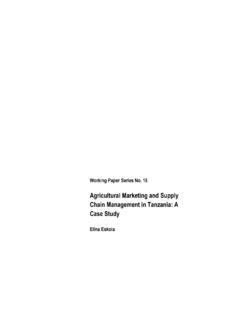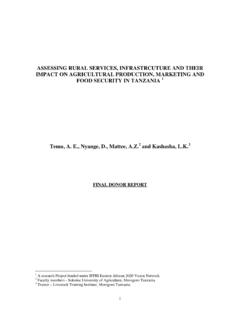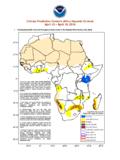Transcription of AGRICULTURAL TECHNOLOGY ECONOMIC VIABILITY AND …
1 AGRICULTURAL TECHNOLOGY ECONOMIC VIABILITY AND. POVERTY ALLEVIATION IN tanzania . by Festus Limbu Economics Department University of Dar Es salaam tanzania . Paper presented at THE STRUCTURAL TRANSFORMATION POLICY WORKSHOP. Organized by the ECAPAPA, TEGEMEO INSTITUTE, and MICHIGAN STATE UNIVERSITY. 27-30 June 1999. Sarena Hotel, Nairobi KENYA. AGRICULTURAL TECHNOLOGY ECONOMIC VIABILITY AND. POVERTY ALLEVIATION IN tanzania . TABLE OF CONTENTS. 1. INTRODUCTION 1. 2. INSTITUTIONAL ASPECTS OF AGRICULTURAL TECHNOLOGY . DEVELOPMENT IN tanzania 5. 3. THE ECONOMICS OF SELECTED AGRICULTURAL TECHNOLOGIES. AND THE LINK WITH POVERTY 10.
2 4. THE POTENTIAL OF SELECTED TECHNOLOGIES IN ALLEVIATING. POVERTY IN tanzania 34. 5. FACTORS HINDERING POVERTY ALLEVIATION THROUGH IMPROVED. AGRICULTURAL TECHNOLOGIES IN tanzania 41. 6. CONCLUDING REMARKS 46. Bibliography 47. Appendicies 51. i Abbreviations ADT Animal Draught-power TECHNOLOGY CARMATEC Center for AGRICULTURAL Mechanization TECHNOLOGY DRD Department of Research Development HYV High Yielding Variety MAC Ministry of Agriculture and Co-operatives NARIs National AGRICULTURAL research Institutes NARS National AGRICULTURAL research System NBRP National Bean Research Programme NMRP National Maize Research Programme SUA Sokoine University of Agriculture UAC Uyole AGRICULTURAL Center URT United Republic of tanzania ii 1.
3 INTRODUCTION. All indicators suggest that agriculture in tanzania is, thirty seven years after independence, still underdeveloped. Available information confirms that use of modern AGRICULTURAL TECHNOLOGY is not a common practice. According to the 1994/95. National Sample Census of Agriculture out of every ten holders, only three use improved seeds; four use farm yard manure; two use chemical fertilizers (and this is mainly in seven out of the total twenty regions); three use pesticides, insecticides, or herbicides; six receive advice from extension agents. The common farm implement owned by all holders is the hand hoe.
4 Out of ten holders, eight own an axe, eight big knife matchet, seven a motar, five a grinding stone, and one owned a plough. Out of a thousand holders, four own harrows, one a tractor, five get AGRICULTURAL credit, and irrigation is carried out only by three holders mainly in only three regions (URT, MAC: 1996). AGRICULTURAL production in the country is dominated by smallholders who produce about 75 percent of total population. About million households in the rural community are engaged in small scale agriculture (World Bank 1994). More than 60 percent of the rural populations live in absolute poverty. Land and labour productivity in agriculture are well below what they could be.
5 Average yields in kilograms per hectare of crops (1994/95) are very low: maize 1630, paddy 1580, wheat 1382, sorghum 1216, and 625 beans (URT; MAC 1998). Increasing the productivity of land already under cultivation and increased use of labour saving technologies are necessary components of efforts to alleviate poverty in developing countries including tanzania where agriculture is a lead sector. An assumption is often made that there are adequate profitable technologies on the shelf in tanzania which farmers can use to increase productivity, and incomes and hence reduce the level of poverty. But because of the way in which AGRICULTURAL research has been organized for decades, we know that ECONOMIC assessment of these technologies has not been sufficiently integrated with the process of AGRICULTURAL TECHNOLOGY development.
6 Most technologies have been released based on attributes like high yield, early maturity and taste rather than on being based on ECONOMIC benefit. ECONOMIC VIABILITY of technologies has in reality not been a concern of AGRICULTURAL researchers, but it remains a very important attribute that a farmer 1. continuously assesses in deciding whether or not to use a particular TECHNOLOGY . It is also the case that some of the technologies are not clearly defined, what is the TECHNOLOGY being addressed and what are its unique characteristics and contribution to the total output? How does profitably combine with other technologies?
7 The problem this study looks into is the issue of low adoption of AGRICULTURAL TECHNOLOGY . Many of the problems with adoption seem to be outside their domain of the National AGRICULTURAL Research Institutes (NARIs). The extension systems have not worked to expectation of beneficiaries, inputs were not available or were too costly, farmers lacked information or had a set point of satisfaction and would not make an effort to produce more. It appears that researchers are not aware of the ECONOMIC return to be derived from shifting from an existing variety to a new one they were developing. The ECONOMIC benefit of AGRICULTURAL technologies is one factor that influences adoption of the technologies developed.
8 In numerous occasions, the adoption of these technologies may have been difficult, either because the technologies proposed, were not sufficiently adapted or because they presented ECONOMIC risks, contradicted local culture, or were constrained by inadequate accompanying ECONOMIC policies. Studies on the ECONOMIC VIABILITY of recommended AGRICULTURAL technologies are meant to provide some insights into the extent to which the recommended technologies are profitable. More specifically this study attempts to answer the following questions: what are the recommended AGRICULTURAL technologies in tanzania ? Are the recommended technologies profitable?
9 If yes, at what level, and to what extent in relation to other competing enterprises at the farm household setting? If they are not profitable, what are the implications for policies related to AGRICULTURAL research agenda for the programme leaders within NARIs, for research administrators within NARIs and to the Ministry of Agriculture and Co-operatives? If the TECHNOLOGY is profitable and yet adoption is low, what are the policy areas that may be hindering the process of adoption and what should be done to mitigate them? This study is important because AGRICULTURAL TECHNOLOGY , its development, transfer and adoption are fundamental in increasing productivity, rural incomes, growth and subsequently in contributing to poverty reduction.
10 This is particularly important in semi-subsistence agriculture which is typical of the countries of eastern and central Africa. The aim is to develop, promote and support market oriented, 2. demand driven research. NARIs should be helped to focus their research programmes on those issues where improved technologies create measurable ECONOMIC impact at the farm level. The objective should be to promote ECONOMIC growth by developing, introducing and disseminating AGRICULTURAL technologies which both create markets and respond to future ECONOMIC opportunities for new technologies as well as maintaining the long term sustainability of the natural resource base.









